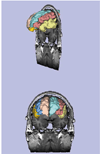A review of MRI findings in schizophrenia
- PMID: 11343862
- PMCID: PMC2812015
- DOI: 10.1016/s0920-9964(01)00163-3
A review of MRI findings in schizophrenia
Abstract
After more than 100 years of research, the neuropathology of schizophrenia remains unknown and this is despite the fact that both Kraepelin (1919/1971: Kraepelin, E., 1919/1971. Dementia praecox. Churchill Livingston Inc., New York) and Bleuler (1911/1950: Bleuler, E., 1911/1950. Dementia praecox or the group of schizophrenias. International Universities Press, New York), who first described 'dementia praecox' and the 'schizophrenias', were convinced that schizophrenia would ultimately be linked to an organic brain disorder. Alzheimer (1897: Alzheimer, A., 1897. Beitrage zur pathologischen anatomie der hirnrinde und zur anatomischen grundlage einiger psychosen. Monatsschrift fur Psychiarie und Neurologie. 2, 82-120) was the first to investigate the neuropathology of schizophrenia, though he went on to study more tractable brain diseases. The results of subsequent neuropathological studies were disappointing because of conflicting findings. Research interest thus waned and did not flourish again until 1976, following the pivotal computer assisted tomography (CT) finding of lateral ventricular enlargement in schizophrenia by Johnstone and colleagues. Since that time significant progress has been made in brain imaging, particularly with the advent of magnetic resonance imaging (MRI), beginning with the first MRI study of schizophrenia by Smith and coworkers in 1984 (Smith, R.C., Calderon, M., Ravichandran, G.K., et al. (1984). Nuclear magnetic resonance in schizophrenia: A preliminary study. Psychiatry Res. 12, 137-147). MR in vivo imaging of the brain now confirms brain abnormalities in schizophrenia. The 193 peer reviewed MRI studies reported in the current review span the period from 1988 to August, 2000. This 12 year period has witnessed a burgeoning of MRI studies and has led to more definitive findings of brain abnormalities in schizophrenia than any other time period in the history of schizophrenia research. Such progress in defining the neuropathology of schizophrenia is largely due to advances in in vivo MRI techniques. These advances have now led to the identification of a number of brain abnormalities in schizophrenia. Some of these abnormalities confirm earlier post-mortem findings, and most are small and subtle, rather than large, thus necessitating more advanced and accurate measurement tools. These findings include ventricular enlargement (80% of studies reviewed) and third ventricle enlargement (73% of studies reviewed). There is also preferential involvement of medial temporal lobe structures (74% of studies reviewed), which include the amygdala, hippocampus, and parahippocampal gyrus, and neocortical temporal lobe regions (superior temporal gyrus) (100% of studies reviewed). When gray and white matter of superior temporal gyrus was combined, 67% of studies reported abnormalities. There was also moderate evidence for frontal lobe abnormalities (59% of studies reviewed), particularly prefrontal gray matter and orbitofrontal regions. Similarly, there was moderate evidence for parietal lobe abnormalities (60% of studies reviewed), particularly of the inferior parietal lobule which includes both supramarginal and angular gyri. Additionally, there was strong to moderate evidence for subcortical abnormalities (i.e. cavum septi pellucidi-92% of studies reviewed, basal ganglia-68% of studies reviewed, corpus callosum-63% of studies reviewed, and thalamus-42% of studies reviewed), but more equivocal evidence for cerebellar abnormalities (31% of studies reviewed). The timing of such abnormalities has not yet been determined, although many are evident when a patient first becomes symptomatic. There is, however, also evidence that a subset of brain abnormalities may change over the course of the illness. The most parsimonious explanation is that some brain abnormalities are neurodevelopmental in origin but unfold later in development, thus setting the stage for the development of the symptoms of schizophrenia. Or there may be additional factors, such as stress or neurotoxicity, that occur during adolescence or early adulthood and are necessary for the development of schizophrenia, and may be associated with neurodegenerative changes. Importantly, as several different brain regions are involved in the neuropathology of schizophrenia, new models need to be developed and tested that explain neural circuitry abnormalities effecting brain regions not necessarily structurally proximal to each other but nonetheless functionally interrelated. (ABSTRACT TRUNCATED)
Figures






References
-
- Adler LE, Olincy A, Waldo M, et al. Schizophrenia, sensory gating, and nicotinic receptors. Schizophr. Bull. 1998;24:189–202. - PubMed
-
- Akbarian S, Bunney WE, Jr, Potkin SG, et al. Altered distribution of nicotinamideadenine dinucleotide phosphatedia-phorase cells in frontal lobe of schizophrenics implies disturbances of cortical development. Arch. Gen. Psychiatry. 1993a;50:169–177. - PubMed
-
- Akbarian S, Vinuela A, Kim JJ, et al. Distorted distribution of nicotinamideadenine dinucleotide phosphatediaphorase neurons in temporal lobe of schizophrenics implies anomalous cortical development. Arch. Gen. Psychiatry. 1993b;50:178–187. - PubMed
-
- Altshuler LL, Bartzokis G, Grieder T, et al. Amygdala enlargement in bipolar disorder and hippocampal reduction in schizophrenia: an MRI study demonstrating neuroanatomic specificity [letter] Arch. Gen. Psychiatry. 1998;55:663–664. - PubMed
-
- Alzheimer A. Beitrage zur pathologischen anatomie der hirnrinde und zur anatomischen grundlage einiger psychosen. Monatsschrift fur Psychiarie und Neurologie. 1897;2:82–120.
Publication types
MeSH terms
Grants and funding
LinkOut - more resources
Full Text Sources
Other Literature Sources
Medical

